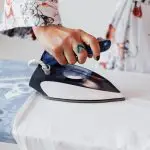Struggling with dried Elmer's glue on your carpet can feel like a sticky situation, but fear not! With these 7 fabric-friendly tricks, you'll be able to tackle the problem like a pro.
From using a simple vinegar and water solution to the power of rubbing alcohol, these techniques are designed to help you master the art of removing dried glue from your carpet without causing damage.
So, whether it's an accidental spill or a crafty mishap, you can confidently handle the situation with these expert tips.
Let's dive in and discover how to restore your carpet to its pristine condition!
Key Takeaways
- Vinegar and water solution can be used to soften dried glue on carpet.
- Rubbing alcohol or hydrogen peroxide can be effective in removing dried glue.
- Dish soap and warm water can be used to gently blot and lift dried glue stains.
- Enzyme-based carpet cleaners are safe for fabrics and can effectively break down dried glue.
Vinegar and Water Solution
To start removing dried Elmer's glue from carpet using a vinegar and water solution, first mix equal parts white vinegar and water in a spray bottle. Vinegar benefits from its acetic acid content, which helps break down the glue's bond with the carpet fibers. The water dilution ensures that the solution isn't too harsh on the carpet fibers while still being effective.
Once the solution is ready, generously spray it onto the dried glue, ensuring it's thoroughly saturated. Allow the vinegar and water solution to sit and penetrate the glue for about 5-10 minutes. This gives the acetic acid enough time to soften the glue, making it easier to remove.
After the solution has set in, gently blot the area with a clean cloth, working from the outside towards the center to prevent spreading the glue. You may need to repeat the spraying and blotting process a few times to fully remove the dried Elmer's glue from the carpet.
Rubbing Alcohol
After saturating the dried Elmer's glue with the vinegar and water solution, you can proceed to tackle any remaining residue by applying rubbing alcohol. When using rubbing alcohol to remove dried Elmer's glue from carpet, it's crucial to consider fabric safety and carpet colorfastness.
Here are some tips to effectively and safely use rubbing alcohol for this purpose:
- Alcohol alternative: If you're concerned about using rubbing alcohol, you can consider using a mild dish detergent mixed with water as an alternative. This can be a gentler option for delicate fabrics or carpets with uncertain colorfastness.
- Fabric safety: Before applying rubbing alcohol, it's essential to test it on a small, inconspicuous area of the carpet to ensure that it doesn't cause any damage or discoloration. This simple test can help you avoid potential fabric safety issues.
- Rubbing alcohol precautions: When using rubbing alcohol, remember to work in a well-ventilated area to avoid inhaling fumes. Additionally, avoid using excessive amounts of rubbing alcohol, as it can saturate the carpet and cause further damage.
Dish Soap and Warm Water
You can start by mixing a small amount of dish soap with warm water in a bowl. Using a clean cloth, dip it into the soapy water and gently blot the dried Elmer's glue stain on the carpet. Avoid rubbing aggressively, as this can spread the glue and embed it further into the carpet fibers. Once you've gently blotted the glue stain, use a dry cloth to soak up any excess moisture. Repeat the process until the glue stain begins to lift. After the stain is removed, use a clean cloth dampened with water to rinse the area and then blot it dry.
Here's a helpful table outlining some carpet maintenance tips and DIY solutions:
| Carpet Maintenance Tips | Carpet Cleaning Tools | DIY Solutions |
|---|---|---|
| Regular vacuuming | Vacuum cleaner | Baking soda and essential oils for deodorizing |
| Immediate stain treatment | Stain remover spray | Vinegar and water solution for common stains |
| Professional cleaning every 12-18 months | Carpet steamer | Club soda for fresh spills |
Following these stain prevention and carpet maintenance tips, along with utilizing the right carpet cleaning tools and DIY solutions, can help you keep your carpet looking its best.
White Vinegar and Baking Soda Paste
Continuing from the previous subtopic, mix white vinegar and baking soda to create a paste for removing dried Elmer's glue from carpet. This natural cleaning solution utilizes a chemical reaction to break down the glue, making it easier to remove from the carpet fibers.
- Start by combining equal parts of white vinegar and baking soda in a bowl to form a paste.
- Apply the paste directly to the dried glue on the carpet, ensuring that it covers the affected area completely.
- Allow the paste to sit on the glue for at least 15-20 minutes to allow the chemical reaction to work its magic.
After the wait time, gently scrub the area with a soft-bristled brush or cloth to lift the softened glue from the carpet fibers.
This method is effective and fabric-friendly, making it a great option for tackling dried Elmer's glue stains on carpets. Plus, using natural cleaning solutions like white vinegar and baking soda provides a safe and eco-friendly alternative to harsh chemical cleaners.
Ice and Butter Knife
If you've got dried Elmer's glue on your carpet, using ice and a butter knife can be a game-changer.
By placing ice on the dried glue, you can make it hard and easier to remove.
Then, gently use a butter knife to scrape off the hardened glue, followed by some careful carpet brushing.
Ice for Hardening Glue
To harden the dried Elmer's glue on your carpet, place an ice pack or ice cubes wrapped in a cloth over the affected area for several minutes. This freezing technique will help solidify the glue, making it easier to remove. Once the glue has hardened, gently scrape off as much as possible with a butter knife, taking care not to damage the carpet fibers.
Here are some tips for using ice to remove dried glue from your carpet:
- Wrap the ice in a cloth to prevent moisture from soaking into the carpet.
- Avoid pressing too hard with the ice pack to prevent damage to the carpet fibers.
- Use a gentle back-and-forth motion when scraping the hardened glue with a butter knife to avoid pulling up the carpet strands.
Butter Knife for Scraping
First, carefully slide a butter knife under the hardened glue, using a gentle back-and-forth motion to scrape off as much as possible without causing damage to the carpet fibers.
The key to successful butter knife techniques is to work slowly and patiently, avoiding any aggressive movements that could fray or tear the carpet.
As you scrape, periodically check the blade for glue buildup and gently remove it to prevent re-depositing the glue onto the carpet.
Keep in mind that scraping dried glue off the carpet may take time and multiple passes, especially for larger or more stubborn areas.
Be persistent but gentle, and remember that it's better to remove the glue gradually than to rush and risk damaging the carpet fibers.
Gentle Carpet Brushing
You can gently brush the area with a carpet brush, using an ice cube to help harden the glue and a butter knife to carefully lift off the hardened residue. When employing gentle agitation, remember to avoid scrubbing too hard to prevent damaging the carpet fibers.
Here are some tips to protect your carpet while removing dried Elmer's glue:
- Use a soft-bristled carpet brush to gently work the hardened glue, avoiding harsh scrubbing.
- Place a cloth or paper towel under the affected area to absorb any melted glue or excess moisture.
- Test a small, inconspicuous area of the carpet with the ice and butter knife method to ensure it doesn't cause any damage.
Hydrogen Peroxide
If you've discovered dried Elmer's glue on your carpet, you can start by carefully applying hydrogen peroxide to the affected area using a clean cloth. Hydrogen peroxide is a gentle yet effective option for breaking down dried glue without damaging the carpet fabric. When using hydrogen peroxide, it's important to ensure that your carpet is compatible with this solution. Before application, test a small, inconspicuous area of the carpet to check for any adverse reactions.
Once you've confirmed the compatibility, dampen a clean cloth with hydrogen peroxide and gently dab at the dried glue. Avoid rubbing or scrubbing vigorously, as this could push the glue further into the carpet fibers. Let the hydrogen peroxide sit on the affected area for a few minutes to allow it to penetrate the glue.
Then, using a clean, damp cloth, blot the area to lift the glue and hydrogen peroxide from the carpet. Repeat the process as necessary until the dried Elmer's glue is completely removed, then allow the carpet to air dry.
Enzyme-Based Carpet Cleaner
If you're looking for an effective and safe way to remove dried Elmer's glue from your carpet, an enzyme-based carpet cleaner might be the solution you need.
These cleaners are specifically designed to break down tough stains and are safe for use on various fabrics.
With their powerful stain-fighting capabilities, enzyme-based carpet cleaners can help you tackle the challenge of dried glue on your carpet.
Effective Stain Removal
To effectively remove dried Elmer's glue from carpet, start by applying an enzyme-based carpet cleaner to the stained area. Follow these steps for effective stain removal:
- Gently blot the stained area with a clean cloth to remove excess glue.
- Apply the enzyme-based carpet cleaner according to the product instructions and let it sit for the recommended time to break down the glue.
- Use a clean cloth to blot and lift the loosened glue from the carpet fibers.
By following these steps, you can effectively remove dried Elmer's glue from your carpet, leaving it clean and free from stains.
Additionally, consider implementing preventive measures to avoid future spills and explore DIY carpet cleaning techniques to maintain the overall cleanliness of your carpets.
Safe for Fabrics
You can safely remove dried Elmer's glue from carpet using an enzyme-based carpet cleaner that is safe for fabrics and effective at breaking down tough stains. When choosing a carpet cleaner, look for one that is specifically formulated to be safe for fabrics, ensuring it won't cause any damage or discoloration. An enzyme-based cleaner is gentle on carpets while being tough on glue stains. It works by breaking down the dried glue, making it easier to lift off the carpet fibers without causing any harm. Additionally, these cleaners often provide fabric protection, creating a barrier that helps prevent future glue stains from setting in. Here's a table summarizing the benefits of using an enzyme-based carpet cleaner:
| Benefits | Description |
|---|---|
| Safe for Fabrics | Won't cause damage or discoloration to carpets. |
| Effective Stain Removal | Breaks down dried glue, making it easier to lift off the carpet. |
| Fabric Protection | Creates a barrier to prevent future glue stains from setting in. |
Frequently Asked Questions
Is Elmer's Glue Safe for All Types of Carpet Materials?
Elmer's glue is generally safe for most carpet materials, but it's important to test on a small, hidden area first. When removing dried glue from carpet, be cautious to avoid damaging the fibers.
Can I Use These Methods on Colored or Patterned Carpets Without Causing Damage?
You can use these methods on colored or patterned carpets without causing damage. They're designed to protect your carpet's color and pattern while effectively removing stains and preserving the carpet's overall appearance.
Will These Methods Work on Old and Stubborn Dried Elmer's Glue Stains?
Yes, these methods are effective for removing old and stubborn dried Elmer's glue stains. The fabric-friendly tricks are specifically designed to tackle tough stains without causing damage to colored or patterned carpets.
Are There Any Potential Risks or Side Effects of Using These Methods on My Carpet?
Using these methods on your carpet may have potential risks like discoloration or material damage. However, if you follow the instructions and test a small area first, you can ensure the safety of your carpet.
Can I Use These Methods on Other Types of Adhesives or Glue Stains Besides Elmer's Glue?
Yes, you can use these methods on alternative adhesives and glue stains besides Elmer's glue. It's important to test on a small, inconspicuous area first, as different carpet materials may react differently.
- Recycling Nonwoven Fabrics: Is It Possible? - July 11, 2025
- Recycling Nonwoven Fabrics: Is It Possible? - July 11, 2025
- Recycling Nonwoven Fabrics: Is It Possible? - July 11, 2025







